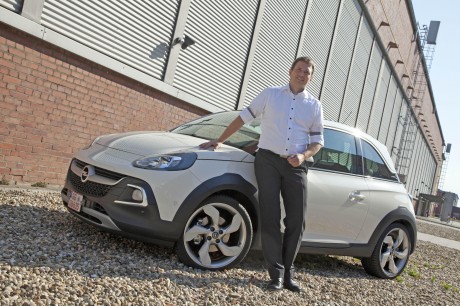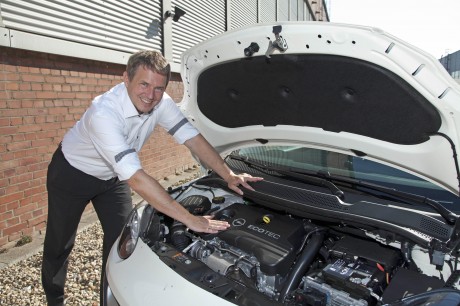Opel is currently in the midst of the largest rollout of new engines in its history. The company will be introducing 17 new power plants from 2014 to 2018. One of the major highlights is the cutting-edge three-cylinder gasoline model, which promises efficient turbocharging in spite of the fact that it is only a one-liter engine. The Opel engineers of the International Technical Development Center (ITEZ) in Rüsselsheim, Germany, developed this direct injection engine, which, along with the completely new six-speed manual transmission, will be making its debut in the ADAM ROCKS – which has just been officially presented in Riga, the capital of Latvia.
Dr. Matthias Alt is the head of the development team at Rüsselsheim and Chief Engineer for small gasoline engines at Opel. Before beginning the interview, the 43-year-old engineer takes a seat inside an 85-kW/115-hp ADAM ROCKS 1.0 ECOTEC Direct Injection Turbo.
1. Mr. Alt, the new three-cylinder turbocharged gasoline direct injection engine will be making its debut in the ADAM and ADAM ROCKS. How do the power plant and the vehicle fit together?
Alt: I just had to take one more spin in the ADAM ROCKS on the factory grounds before the vehicles were transferred to Riga. This combination is a recipe for pure driving fun. The strong performance of the power plant shows what effective downsizing can bring to the table. Even at low rpm, the small turbocharged engine reaches its peak torque of 170 Nm. This means that the three-cylinder engine performs over 30 percent better than a 1.6-liter normally-aspirated engine. Everything runs like clockwork – the vehicle displays extremely good response without a hint of turbo lag. The engine and the ADAM ROCKS work together in perfect harmony, giving the vehicle a sporty feeling and making it a true pleasure to drive.
2. It required a lot of work to create this degree of harmony…
That’s true. Our validation specialists drove the vehicles hundreds of kilometers – clear across Europe – in order to test the engine, transmission, and chassis, and ensure that these components worked together perfectly. We had to fine-tune the vehicles both in southern Spain at temperatures of over 40 degrees, and in northern Sweden at minus 30. My favorite validation route leads up the Grossglockner. Here we perform a test to determine whether the engine is able to deliver full performance even in thin air at higher elevations. We also optimized the start-stop mode of the new six-speed transmission by testing the vehicles in city traffic.

Proud of the result: Matthias Alt shows off the ADAM ROCKS, which has been officially presented in Riga these days.
3. The common aim coded into the DNA of the new engine series developed by Opel is to raise the bar when it comes to refinement. Three-cylinder engines are known for their harsh running characteristics, so it’s no easy task that you and your team faced.
We started with a very clear vision: We wanted to show that we could not only reduce consumption and emissions; we also wanted to prove that a three-cylinder engine had as much to offer in terms of refinement as drivetrains with four or more cylinders. We wanted to completely re-imagine the characteristics of conventional three-cylinder engines in terms of smoothness – that is, the noise and vibration characteristics of the engine. So our development process started with a blank slate.
4. Let’s start with noise characteristics. How did you approach the problem?
There are two basic approaches here. Either we could retrofit the unit with sound insulation blankets at great cost, or we could attack the root cause of the problem. We chose the latter approach and proceeded to address 40 different components and component groups in order to develop new noise-optimized solutions. One of the main components here is the die-cast aluminum engine block. It is not only lightweight; it also helps to insulate noise emissions. We also insulated the high-pressure injection system separately from the cylinder head. This prevents vibrations from being transmitted. The specially designed intake manifold and camshaft housing, along with the insulated crankshaft, work to minimize noise development. We also designed an acoustically-optimized fuel pump and fuel lines.
5. And how were you able to effectively reduce the vibrations?
It was a difficult problem, but it ended up being worth the effort. We mounted a balance shaft in the oil sump. Driven by a chain with inverted teeth for quiet running, this counter-rotating shaft revolves at crankshaft speed and is mass-optimized to offset the inherent vibrations from a three-cylinder engine. The result of this high-precision engineering is that the new 1.0 ECOTEC Direct Injection Turbo not only runs more quietly than other three-cylinder engines; in fact, it is also quieter than many four-cylinder engines.

The engineer and his engine: Matthias Alt worked with a 200-man team to develop the 1.0 ECOTEC Direct Injection Turbo available in two performance levels.
6. So we’re talking about an engine that’s small in size while delivering top performance and offering a high level of refinement. How does this unit perform when it comes to fuel consumption?
One of the major decisions we made before even beginning our development work was to keep the budget of our customers in mind – and we worked hard to keep costs down. To ensure efficient combustion, for example, we placed the fuel injectors in a central position above the pistons. The two-stage oil pump and the water pump, which can be switched off as needed, also help to reduce consumption. The results are clear: The fuel consumption of the 66-kW/90-hp version is 4.3 liters per 100 kilometers. The 115-hp ADAM ROCKS version, on the other hand, clocks in at 5.1 liters per 100 kilometers due in part to special features, such as increased ground clearance and larger wheel arches.
7. How large was the team that you worked with on the new three-cylinder engine?
Over 200 of my fellow workers at the ITEZ in Rüsselsheim worked on the new three-cylinder engine for three and a half years. We built 1,600 prototypes and carried out extensive simulations – in fact, our simulations penetrated deeper into the engine than ever before. But all that work was worth the effort. The entire team is proud of the results we achieved.
Dr. Matthias Alt has worked for more than 16 years at the company. After completing his degree in engineering in Stuttgart, Alt joined Opel in the 1990s as a design engineer in Advanced Engineering.
He was named ‘Most Valuable Colleague’ for his research and development work, for which he was presented a GM Innovation Award in 2008.
Most recently, Alt, who now holds a Ph.D. in Automotive Engineering, has distinguished himself in the area of transmission engineering and internal combustion engine development.